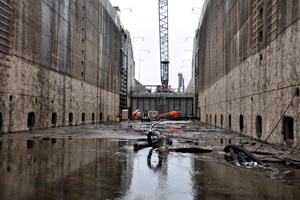Depression-Era River Lock Infrastructure Crumbling as $9.2 Billion in Repairs Goes Unfunded

One of the essential elements of infrastructure in the United States is the river lock. Most locks close off a 600- to 1,200-foot stretch of river and raise and lower the water in the sealed-off chamber.
Towboats and barges enter and exit the locks to travel between sections of river that are at different levels. The United States has 242 locks in operation on 12,000 miles of navigable waterways.
In 2013, $216 billion in freight moved along them, including the Mississippi, Ohio, and Illinois rivers.
Moving oil, coal, soybeans and cement by barge is much cheaper than by rail or highway: Without the locks, such low-cost shipping would be nearly impossible.
The locks are in dire need of repair and replacement. Mechanized gates get stuck, and chunks of concrete are falling off walls battered by barges.
In October 2011, a 280-foot section of wall by the Lockport Lock in Illinois crumbled into the water. In 2013, the Algiers Lock in Louisiana was shut down for four months to repair an underwater part that failed. The shutdown cost businesses $146 million in lost revenue and the expenses of rerouting cargo along other waterways. Some of the hydraulic motors powering the locks were installed in the 1930s. Many of the older locks with 600-foot-long chambers are too small to accommodate the towboat and its typical 15-barge load: The boats have to split up the barges and make two trips through the small locks.
The U.S. Army Corps of Engineers, which manages the system, “continues to Band-Aid the locks to keep them operational,” says Kim Ekena, vice president of Archer Daniels Midland’s American River Transportation. “The thought was the locks would last 50 years. We are getting to a point where we are talking about 70 or 80 years.” Congress authorized improvements last year and in 2015 hiked a tax on diesel fuel to help finance them. Yet the Waterways Council, which represents barge operators, shippers and river ports, estimates that $9.2 billion in essential construction and repairs remains unfunded.
The United States faces a serious rival in Brazil, which since 2007 has been investing in its transportation infrastructure, including river ports to ship soybeans and other commodities for export from large farms in the interior. It has become a top soybean exporter. U.S. market share of soybean exports dropped from 71% in 1992 to less than 50%, according to a February 2015 report by the U.S. Department of Agriculture. The U.S. share could drop further, according to the report.
As the Brazilians keep improving the efficiency of their river freight system, while U.S. river locks struggle to keep cargo moving, buyers of U.S. commodities may tilt more to Brazil. U.S.-based agriculture companies including Archer Daniels Midland and Cargill have been investing in ports and barges in the Amazon to help meet demand from China, the No. 1 soybean importer, as well as other nations. Says Mike Toohey, president of the Waterways Council, “If we’re not prepared, commerce will flow to where you get the best price and reliability.”
Brazil may be in a better position to benefit when the expansion of the Panama Canal is finished next year. The upgraded canal will feature a new lane for bigger ships. As a result, the canal’s cargo capacity will double. With shorter waiting times to get through the canal, more ships will travel more quickly to pick up their Asia-bound cargoes at U.S. and Brazilian ports in the Gulf and on the Atlantic.
Lower transportation costs rather than production costs have kept U.S. soybeans competitive globally, says Mike Steenhoek, executive director of the Soy Transportation Coalition. “If we have these failures at our locks, that will insert a cost into the system. Any kind of benefit you could potentially realize from the Panama Canal expansion will really be moot.”
The Army Corps of Engineers keeps applying those Band-Aids. Michael Cox, chief of operations for the Corps’ Rock Island district, which oversees 20 locks and dams along the Mississippi River and the Illinois Waterway, is encouraged by some recent increases in funding. But he’s still “very concerned because what we are currently doing cannot be sustained for the long term.”




